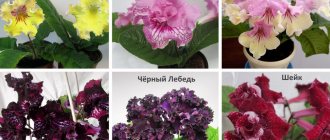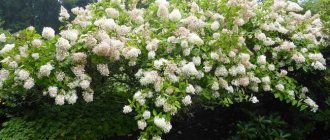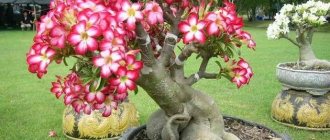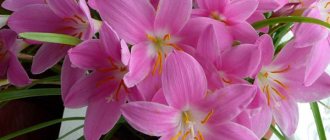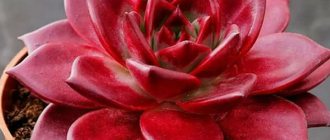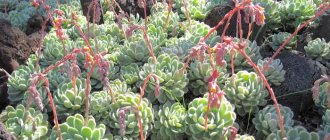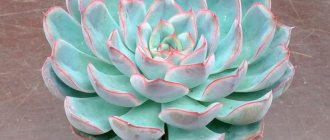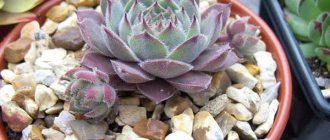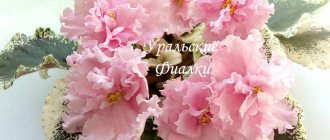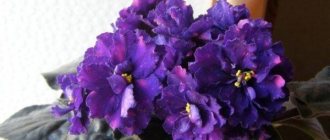International name:
Synonyms:
Characteristics:
| Complexity: |
| Development cycle: |
| Light mode: |
| Watering mode: |
| Temperature: |
| The soil: |
| Key Feature: |
Foliage color
Bud color
Dimensions Flower sizes
Taxonomy:
| Domain: |
| Kingdom: |
| Department: |
| Class: |
| Order: |
| Family: |
| Genus: |
When it comes to the most unusual succulents, the Echeveria Affinis 'Black Knight' plant is certainly a pretty attractive candidate.
Shades of green and black, turning into purple, as well as lush foliage look quite aesthetically pleasing. Moreover, these flowers are easy to care for. If you want to know how to properly care for your Succulent, this guide will help.
Echeveria - what kind of flower is it?
The succulent echeveria is a perennial of the Crassulaceae family. There are about 200 varieties in natural conditions, with a small number grown as ornamental varieties.
Echeveria
In nature, it is distributed in America - California, Peru and Mexico. The name of the species was given in honor of the Mexican artist who described the flora of the country - Atanasio Echeverria y Godoy.
At home, gardeners prefer Echeveria shaviana, which is characterized by a corrugated ridge and leaves with pinkish edges. Echeveria hump-flowered, desmet and agavoides also deserve no less attention.
The crop has bluish-gray foliage; the largest subspecies reach 15 cm in width and 25 cm in length. The stems are smooth and miniature. The foliage is collected in a dense rosette and resembles a rosette in appearance. Some varieties have a smooth surface, others have a pubescent surface.
Botanical description
Echeveria is a herbaceous perennial belonging to the Crassulaceae family. Hot and dry Mexico is considered its homeland, but echeveria is found over a vast territory from northern Peru to the southern states of the United States. The culture received its name in honor of the Mexican illustrator and painter Anastasio Echeveria , who, when compiling an encyclopedia of the flora of Mexico in the 19th century, paid special attention to this particular succulent.
The name Echeveria, which appears in some botanical reference books and articles, is also acceptable. Echeveria in Spanish sounds like Echeveria, and echeveria is a Latin botanical name that is also used in Russian-language sources. The issue of introducing a single name was raised even at international conferences, however, as they say, “things are still there.”
Echeveria does not have a single “standard” of appearance.
It can be either herbaceous or shrub, remain a 3-centimeter crumb or grow into a giant with a diameter of 40 cm. Its leaf blades are dense, fleshy, and can be covered with a silvery-bluish coating , reminiscent of wax to the touch, or with soft thin hairs. This coating helps the succulent not to die under the scorching sun. The peduncles are long (up to 90 cm), the inflorescences are collected in graceful brushes. The flowers are small, shaped like bells in all shades of yellow, red and white. Roots are thread-like or superficial.
Varieties of indoor plants
The species of the echeveria flower are very diverse, there are from 150 to 200 varieties. They grow crops not only in pots, but also in glass flowerpots.
Echeveria elegans
Echeveria - home care and reproduction
Echeveria graceful has grey-bluish foliage and a flat rosette. The shoots are straight, over time they take a horizontal position and spread along the ground, and are able to take root independently in the soil.
Large plants have rosettes up to 15 cm in diameter; children develop on high shoots. The average width of the leaves is 2 cm, length - 5 cm. The inflorescences have a pinkish or bright scarlet hue, with a yellow edging on top.
Important! Varieties with a missing stem also include Echeveria agave. It is valued for its unusual foliage coloring with a transition from a light green center to reddish edges. The surface of the leaf blades is covered with a whitish coating.
Echeveria graceful
Echeveria carnicolor
According to the description, it has a short, branching stem, up to 6 cm in length.
The rosette is medium in size, up to 15 cm high, up to 10 cm wide. The foliage is medium dense, the color resembles meat. It reaches 7 cm in length.
Echeveria glauca
It has gray-blue foliage with a pinkish border along the edges, leaf blades with a bluish waxy coating, resembling a spoon in shape.
The inflorescences are located on lateral peduncles, the flowers are orange-colored.
Important! Echeveria pulidonis also has a bluish tint, but the border is bright red. The bright yellow flowers are bell-shaped.
Echeveria agave
Echeveria Black Prince
The succulent has a fleshy rosette, up to 15 cm in diameter. The foliage has a light green tint, the inflorescences are located in lateral five-membered segments.
The flowers of Echeveria Black Prince with a scarlet-chocolate or orange hue are on a high stalk.
Echeveria Black Prince
Echeveria leucotricha
It belongs to the pubescent varieties; whitish hairs grow on green leaves with a brown border along the edges. Externally, the culture resembles a newborn animal, the diameter of the rosette is up to 20 cm.
Important! Interesting varieties include Echeveria purpuzorum. It has tough, triangular-shaped foliage with pointed tips. The inflorescence reaches 20 cm in length, collected from orange-yellow flowers.
Echeveria fulgens Lera
Small and bushy, with thick shoots extending from the main outlet. Children grow up on them. The foliage has a light green tint and is covered with a waxy coating along the edges.
The standard leaf size is 10 by 4 cm. It blooms with reddish flowers in the February cold.
Important! Echeveria lau also has a waxy coating, which is observed even on the flowers.
Echeveria Derenbergii
The difference between this variety is considered to be the many creeping shoots extending from the main rosette (6 cm in diameter).
The top of the foliage is decorated with a scarlet border, the general shade is bluish-olive or whitish. Spike-shaped inflorescences consist of five flowers, the length of the peduncle is up to 6 cm.
How to care for echeveria at home
Following the rules allows you to get a beautiful and healthy crop that will bloom on schedule, in accordance with the characteristics of the variety. Echeveria, which is not difficult to care for, nevertheless has its own requirements for soil, frequency of moisture and fertilizing.
Illumination and temperature conditions
Echeveria - species: agave, Pulidonis, Black Prince, Purpuzorum, Lilacina
Conditions of detention depend on the time of year and additional factors:
- temperature in the room - in autumn and winter from 10 to 16 degrees, during flowering - from 18 to 21 degrees;
- in spring and summer - feels good in dry air and temperatures up to 30 degrees.
All varieties adore the sun - the color and density of the foliage depends on the amount of light.
Important! Young animals are gradually accustomed to direct sunlight so as not to accidentally burn them. Echeveria does not like spraying or high humidity.
Watering rules and humidity
Water the succulent only after the soil in the pot has thoroughly dried. In winter, the frequency of soil moisture is reduced to a minimum - otherwise, excess water will lead to the tilting of the stem.
Before the procedure, tap water is left to sit for 48-72 hours or aquarium water is used - it will act as a kind of feeding.
Important! You can determine the lack of fluid by the condition of the foliage - it will become limp and wrinkled. When moistening, the liquid is poured under the flower without touching the leaves.
Watering
Fertilizing and soil quality
In the spring and summer, they are fed with special mineral fertilizers for succulents and cacti; procedures are carried out monthly. Starting in the fall and throughout the winter, feeding is not carried out, as is the case after transplanting to new soil. Echeveria does not require organic or nitrogenous fertilizers.
She prefers low-nutrient, sandy and loose soil with a neutral reaction. What suits her best is a ready-made store-bought mixture for succulents and cacti. If you wish, you can make your own soil mixture, choose one of the options:
- mix 1 part turf and leaf soil, 2 parts river sand;
- 1 part loamy and peaty soil and 2 parts coarse sand.
To prevent the development of root rot, a small amount of charcoal is added to the soil mixture.
Important! When planting, a drainage layer is placed in each container - up to 1/3 of the box. Expanded clay, crushed brick, pottery shards or pebbles are used as drainage.
Flower container size
A shallow root system requires a wide pot with minimal depth. Its diameter should be 1.5-2 cm larger than the flower itself.
You should not take products without drainage holes - moisture will stagnate and the roots will rot.
Pruning and replanting
Transplantation work is carried out annually. They act as carefully as possible, trying not to damage the root system and foliage.
After purchasing, the crop needs to be replanted after a few weeks - until the appointed day, watering is completely stopped. The movement takes place with a completely dry earthen ball and only then the soil is moistened.
No special pruning is carried out - the dried lower leaves are regularly removed to preserve the decorative appearance of the crop.
Important! If in the spring the rosette begins to stretch out, then you can cut off the upper part, leaving 3-4 cm. This will rejuvenate the echeveria and produce new shoots.
Transfer
Features of plant flowering
Ficus microcarpa - care and propagation at home
Not all types and hybrids of succulents bloom; some of them require special conditions.
Important! Small echeverias can be combined in mixes when constructing compositions.
Echeveria blooms most often in the spring and summer months and lasts from 2 to 4 weeks.
Most varieties go dormant in winter. This time requires good lighting and a temperature range of 8 to 15 degrees. Watering is reduced to once a month.
A long lateral or vertical peduncle emerges from the rosette; small flowers collected in inflorescences are located on it.
The color of the petals directly depends on the light level. Insufficient light results in yellow flowers, and bright light results in orange or reddish flowers. After flowering ends, babies form on the peduncle.
general information
Echeveria is a perennial succulent and a close relative of the Crassula plant. In nature, it most often grows in Mexico, but in our country it is grown as a houseplant and for decorating alpine slides.
The small massive stem is almost indistinguishable under the dense rosette. Neat but fleshy leaves are collected into a kind of inflorescence, and for this feature Echeveria is nicknamed the stone rose. Most often, the leaves are oval, with a sharp tip.
Sometimes echeveria blooms, and does so very intensely and for a long time. Then it produces thin peduncles with many small bells. With proper care, you can achieve repeated flowering.
Photo: vkusnosushi.ru
Methods for propagating a flower and when is the best time to do it
There are several methods to help propagate the crop. The most convenient methods of propagating echeveria include leaf and rosette.
Echeveria leaf propagation
The leaf is separated from the mother's body and dried for a week. This principle helps to avoid its rotting in the ground. The outer side of the leaf plate is placed on moist soil and rooting is expected at a temperature of 25 degrees. After the first rosette appears, the culture is planted in separate boxes.
Important! Echeveria pearl of Nuremberg is considered convenient for leaf propagation - it feels great with a maximum amount of light and a minimum amount of water.
Propagation by sheets
Reproduction by rosettes
It is one of the popular methods and is carried out by separating the daughter from the mother.
The cut is treated with charcoal powder and dried for 12 hours. Afterwards, the rosette is planted in wet sand and awaits rooting. The method allows you to obtain the rapid appearance of peduncles.
Photos of interesting species (Echeveria Perle von Nurnberg)
In addition to the main species of the Pearl of Nuremberg, there is another interesting species that is found under the general name.
Photo used as illustration. Source: Yandex.Images
Photo used as illustration. Source: Yandex.Images
Photo used as illustration. Source: Yandex.Images
Echeveria Rainbow has the same colors, but divided into stripes. In addition, the stems appear less thin due to their richer color.
Growing problems, diseases and pests
Succulent varieties are rarely attacked by insects and diseases; in most cases, problems arise if they are not properly cared for. Frequent and excessive moisture provokes the development of powdery mildew and root rot. To prevent their appearance, it is necessary to occasionally moisten the soil - only after it has dried to a depth of several centimeters.
Important! If infection has occurred, the crop is replanted by excising the damaged areas and treating them with a fungicide.
Mealybugs and rootbugs pose a particular danger to succulents. They cause growth and development to stop and are identified by a whitish coating and deformation of the flower. Treatment is transfer to a new container with simultaneous removal of damaged areas. At the end of the procedure, treatment is carried out with a solution of Fitoverm and Aktara.
How to deal with them
Treatment depends on the type of problem:
- yellowing of foliage - caused by stagnation of water in the ground, it is recommended to stop moisturizing the echeveria until the earthen clod dries out;
- flaccid and wrinkled leaves occur due to lack of fluid;
- drying out of the lower ones is a normal phenomenon in winter; after falling off, the formation of children begins.
If the leaves of a crop droop and some of them begin to fall off, then the problem is associated with excessive moisture in the winter. If you follow all care recommendations, then major difficulties will not arise.
Echeveria is an original and beautiful flower that is very popular among gardeners. With its help, they decorate greenhouses, alpine slides in their gardens and living spaces in houses. Caring for satin, bristly or black prince echeveria at home does not cause difficulties even for inexperienced gardeners.
Mix of stone roses
Some gardeners have Echeveria mix, which is a combination of several different varieties and varieties of Mexican succulent. The flower arrangement is very elegant, colorful and unusual.
An unusual and graceful plant can be found in hot Mexico. Echeveria is an unpretentious succulent. You can grow the flower both at home and outside, since the stone succulent looks great in landscape design. The stone rose has a beautiful decorative shape and is very much appreciated by flower growers.
